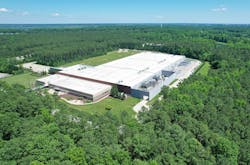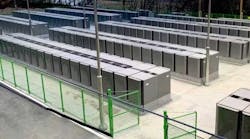CoreWeave, Chirisa Tap Bloom Energy For Illinois AI Data Center Project, Lean Into Microgrids
Bloom Energy will now supply solid oxide fuel cell energy technology for hyperscale developer CoreWeave’s latest data center project in Illinois -- and perhaps beyond -- as the data industry grows exponentially and seeks out cleaner, resilient, and on-site power.
As artificial intelligence (AI) and cloud-based capacity continues to expand by leaps and bounds, newly built facilities will require a corresponding amount of increased electrical generation capacity, which can be met by lower carbon resources and microgrids.
A research report by Goldman Sachs recently forecasted that at least 47 GW of new data center construction will happen by 2030. All those new gigawatts will require primary and backup power.
The CoreWeave strategic partnership with Bloom Energy will utilize the latter’s proprietary fuel cells to generate electricity for a high-performance data center owned by Chirisa Technology Parks (CTP) in Volo, Illinois.
CTP On the Move in Large-Scale AI/HPC Realm
Chirisa has a long history of data center development in Europe, where its projects include the Dataplex B10 hyperscale data center facility in Dublin.
The company's U.S. operations include 365 Data Centers, which operates in at least 10 markets across the Eastern US; Host.net and Interconnect Miami in Florida; and Digital Fortress in Seattle. All those properties were acquired in an acquisition splurge in 2017.
On July 8 of this year, CTP announced a pair of new hires to lead its design, development, and delivery efforts in furnishing build-to-suit hyperscale data center capacity. David Kelly and Meghan Davies have joined the company's senior leadership team to support the rapid expansion of its large-scale AI/HPC data center footprint.
David Kelly joins CTP as Managing Director, US Real Estate, responsible for origination, development, financing and operations across the company's US real estate footprint. With extensive experience in the origination, financing and delivery of large-scale real estate projects across North America, Kelly hails from Ares, where he was a Principal in the company's Commercial Real Estate Group.
Kelly said, "CTP is an exceptional growth story. The company has rapidly emerged as a highly differentiated player in large-scale specialized capacity for the world's leading AI and HPC customers. I am excited by the opportunity to drive the business forward and expand our footprint to support the exponential growth of AI."
Meghan Davis joins CTP as Director, Design, Development and Delivery USA, and will lead the company's business unit responsible for delivery and commissioning of new AI/HPC capacity for large scale customers. Davis hails from Brookfield, where she was a Director in the investment giant's Construction group.
Davis said, "Complex, large scale development is in my DNA. I am thrilled to join CTP to lead the expansion of the company's development capabilities. Rapid delivery of AI and HPC capacity is challenging and thrilling in equal parts. We are at the cutting-edge of this new technology frontier."
From its inception, CTP owns that its strategic focus has been rapid delivery of high-performance facilities based on bespoke designs with top-tier efficiency. The company contends its platform's pipeline of brownfield and greenfield locations in prime data center geographies enables speed to market for new capacity at scale.
Lee Hayes, President and CEO of Chirisa Technology Parks, remarked, "The addition of these exceptionally talented individuals underpins our commitment to meet the urgent requirement for rapid delivery of new capacity for new and existing customers."
CTP's strategic partners include PowerHouse Data Centers and Glenart Developments; the company made its North American debut 2018 with its purchase of 21445 Beaumeade Circle in the heart of Ashburn, Virginia's Data Center Alley.
CoreWeave Further Validates Bloom Energy's AI Play
Chirisa's star tenant CoreWeave provides graphic processing unit cloud-based chip capacity to data centers. The boom in AI has suddenly elevated the company into the stratosphere of cloud computing development.
In May, the self-described "AI hyperscaler" signed a definitive agreement for a $7.5 billion debt financing facility led by funds managed by Blackstone, which also owns QTS Data Centers as part of its digital infrastructure portfolio.
That news followed on the heels of CoreWeave's latest $1.1 billion equity round, which will translate into a lot of GPUs and data center capacity, and featured investors such as Fidelity and Altimeter Capital.
In 2023, CoreWeave more than quadrupled its data center presence from three to 14 operating facilities, and anticipates doubling its data center footprint to 28 globally by the end of 2024.
The company also recently announced its new European headquarters in London, alongside a commitment to invest $1.25 billion in the region.
The former cryptocurrency miner's name was among the first in the hyperscale sector to become synonymous with NVIDIA's GPU business.
“Bloom Energy is thrilled to have been selected by CoreWeave,” Aman Joshi, Bloom Energy’s chief commercial officer, said in a statement. “This validation from CoreWeave, a leader in AI, is a testament to our leading-edge technology and its importance to AI.”
Volo Data Center Dials In Microgrids
As owned by Chirisa Technology Parks and furnished by CoreWeave, the Volo data center near Chicago is a 160,000-square-foot facility with a 14 MW power supply and advanced cooling systems.
The Bloom Energy fuel cells are scheduled to be commissioned by the third quarter of 2025, according to reports.
CoreWeave recognizes how the mission criticality of data centers, which is on an unrelenting growth spurt in the era of new generative AI and cloud-based storage, does not lend itself to intermittent renewables or less energy-dense resources such as solar and storage microgrids. Instead, they require baseload-level power.
“We are seeing a lot of microgrid providers of natural gas solutions or fuel cells offering a 24/7 solution for these larger loads to address utility constraints,” Elham Akhavan, senior microgrid research analyst at Wood Mackenzie, told Microgrid Knowledge [DCF's sibling publication] back in April.
Akhavan added, “Up until recently , large load facilities have had a backup solution and have been grid connected. But because of grid constraints, they are choosing to be off-grid.”
Fuel-cell technology uses an electrochemical process to convert a fuel, such as natural gas or hydrogen, into electricity with only water vapor and heat as the emissions.
Bloom Energy last month announced a collaboration with Sembcorp Industries to potentially utilize the solid oxide fuel cell technology and carbon capture to provide low-carbon power for data centers in Singapore.
In May, semiconductor giant Intel Corp. and Bloom Energy announced a power capacity agreement focused on delivering fuel cell technology for Intel’s data center in Santa Clara, Calif. Bloom Energy also is a long-term energy supplier for Intel.
The International Energy Agency predicts that global data center electricity demand will more than double in coming years, as the growth of AI plays a huge role in that expansion.
Data centers and data transmission currently consume between 2% and 3% of total electricity load worldwide, according to multiple reports -- but that could increase, and is causing utilities and developers to accelerate power generation options.
About the Author

Rod Walton
Rod Walton is Managing Editor of Endeavor Business Media's Microgrid Knowledge and EnergyTech, publications focused on the sustainability and resiliency goals of mission-critical and large-scale energy users, including the commercial and industrial sectors, as well as the military, universities and data centers.
Matt Vincent
A B2B technology journalist and editor with more than two decades of experience, Matt Vincent is Editor in Chief of Data Center Frontier.




